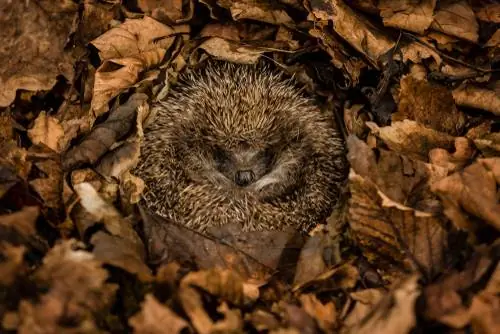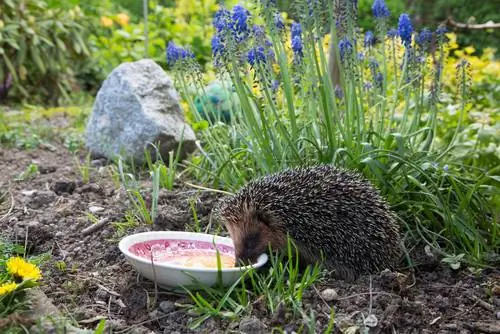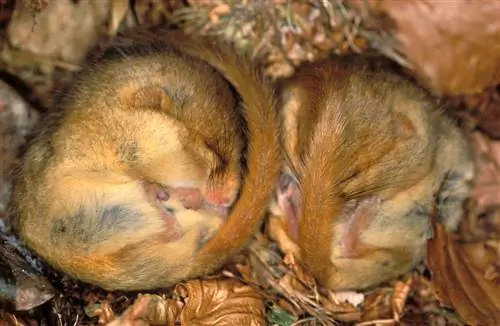- Author admin [email protected].
- Public 2023-12-26 14:17.
- Last modified 2025-06-01 06:02.
Hedgehogs follow a rhythm of life that is unique among insectivores. With an epically long hibernation, the cute spiny animals cheat the seasonal lack of food. This guide illuminates important questions about the ingenious survival strategy.
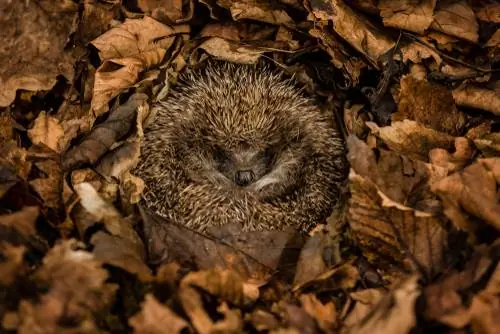
Why and how long do hedgehogs hibernate?
Hedgehogs hibernate to bridge the lack of food in the cold season. They reduce their bodily functions to a minimum and spend four to five months in hibernation. Typically, male hedgehogs begin hibernation in mid-October and female hedgehogs begin hibernation in mid-November.
Do hedgehogs hibernate?
Among insectivores, hedgehogs are the only hibernators. Spiny hedgehogs resort to this survival strategy to bridge the cold season and the associated lack of food. For four to five months, the animals retreat to a weatherproof, well-insulated, spherical nest. Here they curl up and reduce all bodily functions to a minimum. Short periods of wakefulness to go to the toilet are not unusual.
Why do hedgehogs hibernate?
Because there is nothing to eat in winter, hedgehogs sleep through the cold season. The spiny insectivores feed primarily on beetles, maggots, snails and earthworms. After the first frost at the latest, the menu is empty because most of the insects die or retreat to their winter quarters. Since hedgehogs don't stock up, they build up a supply of fat in good time and go into hibernation until the next spring.
Hedgehogs are master energy savers. So that the fat reserves they gain last for many months, they put their little bodies into standby mode. First, hedgehogs curl up into a closed ball. The body temperature drops from 36 degrees to below 10 degrees Celsius. At the same time, the breathing rate drops to one or two breaths per minute. The heart only beats four to five times a minute.
When do hedgehogs hibernate?
Hedgehogs coordinate the beginning and end of hibernation with the weather conditions. Only when bitterly cold nights or the first snow cause their food sources to dry up do hedgehogs retreat to their winter quarters. A look at the calendar only serves as orientation in this regard. Under normal weather conditions, hibernation extends over this period:
- Male: mid-October to mid-March
- Females: mid-November to early April
What the gender difference is based on when hedgehogs go into hibernation and when they wake up is not completely clear. Experts suspect that female hedgehogs need a few weeks longer after raising their young to build up the necessary fat reserves.
Background
Max the hedgehog - lullaby for little rascals
Max the hedgehog's song gets lively bullies in the mood for a relaxed night's sleep. Max the hedgehog loves hibernation and is happy that he can sleep safely under the snow during the cold season. The child-friendly text and the catchy melody are ideal as a sung bedtime story. Once your children's interest in hedgehogs has been aroused, the learning story “Hedgehog Isi and hibernation (€6.00 on Amazon)” explains more details (author: Susanne Bohne, ISBN: 9783752896909)

When do hedgehogs end hibernation?
Between mid-March and mid-April, hedgehogs end their hibernation. Important signals are rising outside temperatures to over 10 degrees Celsius and brighter lighting conditions. It takes several hours until the massively reduced vital functions return to normal levels.
Not every hedgehog needs help - but all help has to be right.

Hedgehogs usually wake up from hibernation at the end of March
Hedgehog found during hibernation - what to do?
The most common cause of hedgehogs being found in winter is cleaning up in the garden. Piles of leaves and brushwood are removed, piles of wood are dismantled for use as firewood, and dogs rummage around. A nest is accidentally uncovered with a deeply sleeping, tightly curled up hedgehog. If the animal shows no reaction, cover the nest again with leaves.
There is no cause for alarm when a hedgehog wakes up from hibernation. After a short period of wakefulness, an alert hedgehog falls asleep again. Sometimes he uses the break to go to the toilet. As long as the nest is intact, there is no need for human intervention.
Hedgehog in hibernation or dead? - How to determine it
A hibernating, live hedgehog is virtually motionless and is often presumed dead. In winter rest mode, the animal only takes three to four breaths per minute, which you will hardly notice visually. An important clue to a living hedgehog in hibernation is its posture. The spiny animal should be tightly rolled into a ball. A dead hedgehog usually lies open and stretched out.
Where does the hedgehog hibernate?
In autumn, hedgehogs look for a sheltered place to hibernate. Mixed hedges, piles of leaves and brushwood are very popular. They also consider a cavity in the wood pile or shed when looking for a safe place to stay. There should therefore be no housing shortage in the hedgehog-friendly garden before winter.
Once a hedgehog has found the perfect winter quarters, it begins building its nest. The preferred building materials are leaves, grass and small branches. The accommodation is padded with soft moss. Since hedgehogs are loners most of the year, they build the spherical nest for themselves.

Laid leaves and wood are ideal winter quarters for hedgehogs
What weight guarantees he althy hibernation?
Winter is a hard time for hedgehogs, associated with a variety of imponderables. There are increasing reports from worried animal lovers because they have encountered a hedgehog looking for food in late autumn or after the first snow. This can be a late-born young animal, a weakened adult or simply an experienced, adult hedgehog who wants to pad out his fat reserves a little. If you have doubts about whether the animal is in need of help, weight is an important indicator. The following table provides information about the key data regarding weight before hibernation:
| Weight assessment at the beginning of winter | Young hedgehog | adult hedgehog |
|---|---|---|
| Ideal weight | larger 500 g | larger 1000 g |
| Minimum weight | 500 to 600 g | 900 to 1500 g |
| Underweight | 300 to 500 g | 800 to 1000 g |
| critical weight | under 300g | under 800g |
Please do not subject a well-fed, he althy hedgehog to the stress of determining its weight. A lively, plump spiny animal is the best at making its own preparations for hibernation. In many cases the prickly sleepyhead has been woken up and is looking for a new place to sleep. However, hedgehogs that are visibly emaciated, weak or apathetic should be weighed in order to be able to make an informed decision about how to proceed.
Please report underweight hedgehogs
Weighing less than 500 grams for young animals and 900 grams for adults, hedgehogs are not equipped to survive months of hibernation. First, note the date, location, time of discovery and weight. Also examine the hedgehog for injuries or obvious illnesses and note the symptoms. Hedgehog droppings provide an important indication of he alth status. Please contact a regional hedgehog rescue center or the veterinarian. Based on the information collected, the experts are available to provide you with advice and support.
Hedgehog wakes up from hibernation too early - what to do?
Capricious weather or initial gardening work often scares hedgehogs out of hibernation too early. If you come across a roaming hedgehog in early to mid-March, the existing insects are far from covering the high food requirements. Now one of the few exceptions applies to supplementary feeding. How to properly feed hedgehogs after hibernation:
- Build a feeding house with two 10×10 cm small entry holes
- Set up a bowl with cat food or a mix of hedgehog dry food and scrambled eggs
- increase the amount of food gradually in the first few days
- Set up a shallow bowl of fresh water
- Renew food and water daily
The supplementary feeding is only intended as a bridge until there are enough insects to prey in the wild. From the end of April/beginning of May at the latest, reduce the daily amount of food so that your prickly boarder can go hunting. The feeding station is finally closed when a young hedgehog weighs at least 500 grams and an adult hedgehog weighs 1000 grams.
Releasing hedgehogs after hibernation - this is how it works
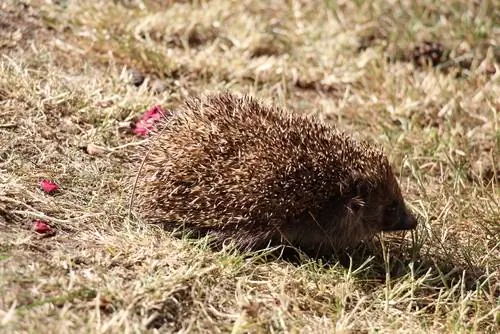
In spring, hedgehogs can be released into the wild step by step
Animal lovers with their own garden provide hedgehog rescue centers with valuable help in releasing young hedgehogs into the wild if they have been raised by hand. Sometimes young or adult hedgehogs that were previously underweight are released into their new territory after a controlled overwintering period. Professional release into the wild is a time-consuming procedure and has nothing to do with half-hearted release into the nearest bushes. This is how you properly release a hedgehog:
- Set up a mobile, escape-proof outdoor enclosure on a flat surface of at least 5 m² (better 10 m²)
- Place a sleeping and feeding house in the middle with 10×10 cm small entrances and exits
- Putting hedgehogs in the outdoor enclosure
- feed for 5 to 7 days
- Open the enclosure and fill the feeding area daily for another 7 days
- reduce the daily amount of food by a third from the 7th day
Thanks to this procedure, the hedgehog can explore its new territory in peace and quiet and find the best places for juicy insects and fat beetles. The feeding station, which is still stocked, gives him the necessary support. If you reduce the amount of food after a week, your prickly pupil will learn without stress that from now on he has to provide his own food.
Frequently asked questions
When do hedgehogs go into hibernation?
When insects become rare in nature in late autumn, an acute lack of food causes hedgehogs to begin hibernation. Before the ground freezes and the first snow falls, the animals retreat to their winter nest. Males usually go into hibernation in mid-October. Females usually eat four weeks longer for their winter fat.
When do hedgehogs wake up from hibernation?
Hedgehogs awaken from hibernation just in time for the beginning of spring. Males leave the sleeping nest in mid-March, whereas females only wake up at the beginning of April. Over the course of the months-long resting phase, the animals lost an average of a third of their weight. Experts suspect that male hedgehogs wake up a few weeks earlier because they need to build up new fat reserves in time before the strenuous mating season begins.
How much does a hedgehog have to weigh to hibernate?
Hedgehog cubs are born until September. These stragglers are often noticed in late autumn because they search for food during the day. If you come across a young animal, you can weigh it. A baby hedgehog should weigh at least 500 grams and not be sick or injured. For an adult, he althy hedgehog, the lower limit is 900 to 1000 grams.
What should we pay attention to when releasing a hedgehog after hibernation?
Releasing a hedgehog after hibernation doesn't mean simply putting it in a bush in the garden. Rather, a slow process of getting used to it has to be completed. Set up an enclosure with a feeding area for 5 to 6 days. Once the hedgehog has learned that there is a food source here, the enclosure is opened and provided with a filled food bowl for another 7 days. This way the hedgehog can explore its territory without stress. After a week, remove the enclosure and feeding place.
Can I move a hibernating hedgehog?
Replacing a hedgehog in hibernation should only take place in urgent, exceptional cases. Prepare a new hibernation place in advance in a protected, shady location. An old wooden wine crate, for example, can be used as a sleeping house. Saw out two cat-proof entrances and exits measuring 10x10 cm. Pad the inside with straw, leaves and moss. You should only move the hedgehog when the new winter quarters are ready.
Can hedgehogs be released shortly before or during winter?
This is easily possible for a he althy hedgehog of normal weight. As wild animals, hedgehogs are excellently adapted to life in the wild, regardless of the current season. However, it becomes problematic for a young hedgehog that is underweight, even if it is otherwise he althy. With less than 500 grams, the young animal does not have sufficient fat reserves to survive months of hibernation. In this emergency, hedgehog rescue stations are available to overwinter endangered hedgehogs under controlled conditions and not release them into the wild until the following spring.
What is the difference between hibernation and hibernation?
When animals go into hibernation, they drastically reduce all life functions. The body temperature drops well below 10 degrees Celsius and you only breathe two to three times per minute. Real hibernators are dormice, marmots or hedgehogs. During hibernation, body temperature, breathing rate and heart rate remain almost normal. There are always short periods of wakefulness to take in food. Squirrels, brown bears and raccoons use this survival strategy.
Tip
Crayons are the perfect tool for children to discover nature in general and hedgehogs in particular. Various sources on the Internet offer a free coloring page on the subject of sleeping hedgehogs, such as the large knowledge publisher for children “School and Family”.

